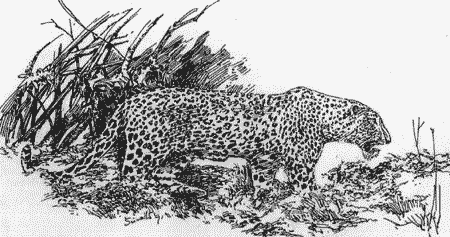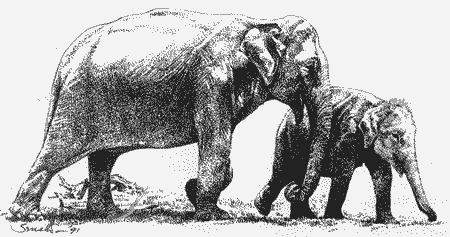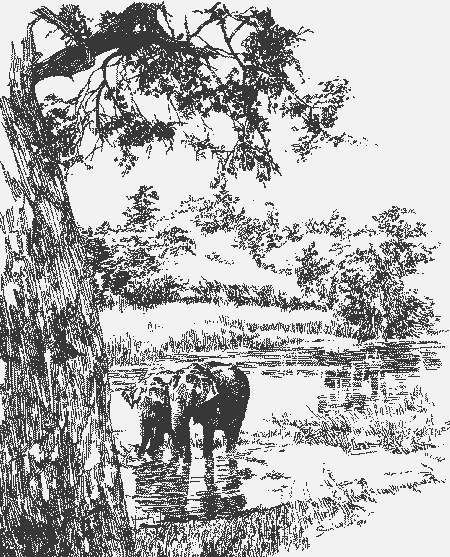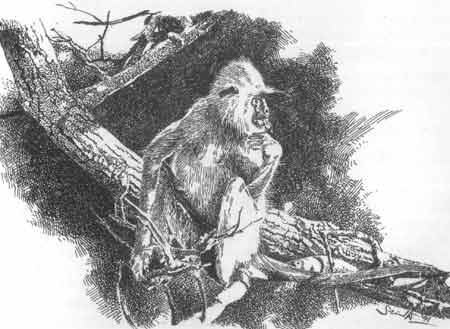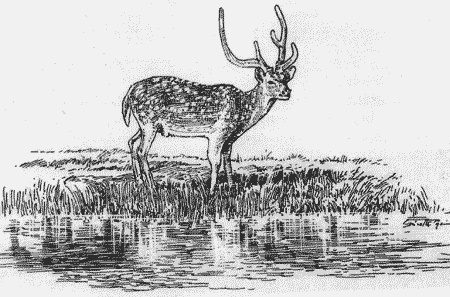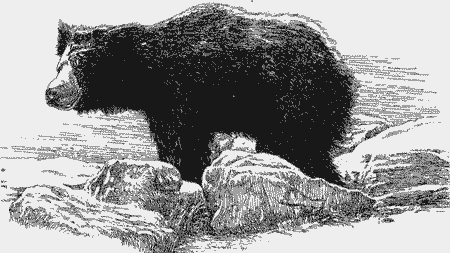|
| |||||||||
 Six weeks in a Cave amidst Leopard, Bear and Elephant
by Sam WickramasingheThe groves were God's first temples —William Cullen Bryant from "A Forest Hymn" Six weeks, as our primitive forefathers lived, in a jungle cave! In 1963, when my friend. His Excellency James George (Jim), the then High Commissioner for Canada, invited me to join him in a safari to an ancient Veddah shrine in the Ruhuna jungles, little did I guess then, that this location could bewitch me so much to draw me there many times subsequently, sometimes to stay weeks in a cave where arahats once lived and bears dwelled now. Going on a 100-year old map of India, Ceylon, Burma and Baluchistan by Bartholomew & Sons of London, which strangely did not bear Kataragama on it but had this spot, hallowed by the Veddahs, indicated thereon as Kebbilitte — meaning ‘potsherd' in Veddah lingo. The journey began from the Karawila Irrigation Circuit bungalow, one week after it was newly opened at Kataragama: in VIP style with all the frills of full diplomatic privilege. The caravan consisted of three four-wheel drives and nine of us: Jim, his wife Carol, daughter Delphi, sons Brian and Graham, and the late Swami Gauribala, Adrian Snodgrass from Australia, a Tamil and myself. Collecting the late, one-armed, Garuwa (of Veddah descent) and pingo carriers for baggage and victuals, from Kumana village, we headed 22 miles upstream of Kumbukkan Oya, to camp the first night sleeping under the stars on the right hank of the river. Next day, leaving the vehicles behind, we began the seven-mile trek along an animal track to reach the place. Garuwa explained the significance of the shrine as we walked... The spot was sacred to the Veddahs who worshipped the Mother Goddess there. He pointed out two large rocks in the river, near the shrine, which were known as 'swearing rocks' according to legend aboriginal men brought their grievances to the goddess and slept the night on these. Justice was meted out to the complainant by a leopard calling and destroying the miscreant. During this first visit, we performed a pooja at three in the morning, as enjoined by Garuwa, following the tradition and style of that of the Veddahs of yore. Seven wells were dug on a sand-bar and all had to bathe seven times from each before marching in single file to the shrine on the other side of the river for the ritual offering of seven kinds of fruit and grain and hailing of rice. The shrine itself was just a bare, circular patch, without any sign of a former building or structure. In the centre a wild tree of some sort grew, rooted by five, thick off-shoots which bore down from about 60 cm above ground. Garuwa said that in the olden days, a tamarind tree stood there, and even today the place was known as Siyambulawa to the villagers who came from Okkampitiya and Monaragala areas, trekking through the forest to offer the first grain after harvesting and for ceremonies involving curses and vows. On the short foot-path from the bank to the shrine, we passed an aged Bo tree (Figus religiosa) and a chaitya in ruin. With this prelude, my second visit a year afterwards with another Australia, Barry Windsor, was full of thrills and excitement... Taking a walk from the shrine towards Kumana along the river, Barry leaned against a stump and tore his toenail. First aid with a strip of my sarong and a wild leaf to stop the blood, together with agitated talk, took our eyes away from the guiding oya as we walked back. Before long, we had missed the path and gone into thick, overgrown wood, with river and track out of sight. It was about 5 p.m. already dark in the dense undergrowth and panic gripped us. The sound of silence all round was sinister and sickening....Just then the pall was shattered by something like a mighty trumpet of a startled elephant. Later, we were to learn that we were fooled by the back of a surprised sambhur in a bush on our way. Battling the gathering fear, Barry climbed a tree and spied something like a high hill to our right. Breaking our cautious way through thick foliage we made towards what was to be our haven for the night...also for a couple of visitors already there before us— elephants having their dinner, quite noisily (fortunately), breaking branches and munching the tender leaves. Getting our scent as we moved, they crashed away into the jungle, leaving our newly found "Hill top Hotel" all for the two of us—two grownup babes lost in the woods! The night advanced steadily, without even a match to light a bonfire or a cover to protect our bare torsos against the chill air. Fortunately, waxing moon and star bright sky gave us some silver light as the darkness slowly dragged on, intermittently broken by the cry or leopard, elephant and bear ...From beacon in the southern horizon we knew that we were somewhere in the direction of the Basses off the southeast coast. The following morning was a journey of archaeological discovery. The place was replete with ruins—walled-up caves with drip-ledges, headless Buddhas and chaityas; ruined by age and treasure hunters. Later, we learned that this was the site of an ancient hermitage, where arahats (spiritually-realized monks) lived about 2,000 years back. This perhaps explained the peculiar silence, almost palpable, which we felt so sharply during the night. The hill was known to the villages as Diwulanagala, owing to the profusion of diwul or woodapple (Feronia limonia) in the area. And some others, more appropriately called it Vihara-gala. Looking across the hill, we were overjoyed to see the ridge of kumbuk (Terminalia arjuna) trees indicating the direction to the river, which appeared to be quite close-by and not far from our open-air camp at the Kebbilitte shrine. In the shrine itself we were in for another thrilling surprise, which made us offer thanks to the jungle ‘deviyo' (god) for veering us away from the return path and putting us up in the hill for the night—a thief had broken into the sack of foodstuffs. A deep impression on the top of the gunny indicated that the sneak had sat on it, and enjoyed the Kraft cheese, tearing off the half-opened lid which was thrown on the ground. What was puzzling was the fact that this thief had only gone for the Australian cheese, leaving all the other tempting "goodies" untouched. Then we spotted the visiting card of the nocturnal prowler—dung—a bear with a weakness for Kraft cheese! Barry muttered a prayer of thanks to the "Deviyo" for his hurt toe, if not for which, he may have been the substitute for the Cheddar! Our six week stay, waging war with only ticks and mosquitoes, was more than compensated with many hair-raising thrills and exciting encounters. More ruins and caves were found, some with still decipherable Brahmi script above their drip-ledges. Reading them, with tracings taken, later in Colombo at the Archaeological Department, we were told that they were in the ancient "Hela" script announcing the gift of land by the monarch to the Sangha. Digging the bottom of a six-foot tall anthill one day to take some clay for the construction of the hearth, we unearthed thick, dish-pattern, clay pottery, later said to be at least 2,000 years old. They were found neatly stacked, before time put up the ant-hill to cover them, suggesting a mass and quick exodus from the site. What could have brought about this, we wondered: enemy attack, famine, pestilence?
In the distance were other imposing hills: the two-humped Dematagala in the south, and beyond it loomed another red giant known as Talaguru-Hela, the hill of the head guru or hill of the brown earth. A monk was rumoured to have lived in tapas (austerity) there. In the northern side, a rod-shaped, chimney-like rock, tall and narrow reminded one of a Siva lingam. On the Diwulanagala rock surface we found many deep holes, 30 cm to 45 cm in diameter. These retained water longest during the drought, and it was interesting to see how elephants have introduced large stones to raise their water levels to drinking position. One day, an ant-eater came right up to my toe, and suddenly getting the scent—too late—ran away in panic and haste! In a kema (rock pool) I surprised a beautiful, young leopard about 10 in the morning, barely 4.5 meters away. When I summoned Barry to witness this rare sight, he came rushing down the hill with axes (we carried no firearms) thinking I was mauled by a bear. The vision of the two bears he had seen the previous evening, just 4 meters away when he ventured to fetch some karapincha (curry leaves) for cooking, was still haunting him! On another occasion, we heard quite a noise, something like a brawl between two humans and investigation revealed two bears fighting near the pond, mid-way down the hill. Our next visit to this spot took place an year later, This time, we stayed during the Wesak and Poson full-moons—over a month —in the largest cave in the Diwulanagala complex. The last two weeks were spent by myself living alone, as Barry had to appear in a court case in Hambantota. One evening, we took a walk out of the cave in the twilight. Before we reached the pond, we heard the unmistakable hoot of a bear approaching us. We got back to our cave-retreat hurriedly, and then noted Barry's absence—he was up a tree He seemed to have a penchant for attracting bears to him, and was also adept in climbing trees to escape them and to find "hotels" in the woods for the lost! Animals never bothered us inside the cave. On Wesak night, an elephant came right up to the entrance and went away after a delightful, half hour's exhibition of it's majestic self. During a siesta one afternoon, I got up to see the slough of a reptile on the dusty floor, a few inches away from my head. It had slithered out of a hole and gone leaving track and skin behind. Barry attributed my good luck and safety to the headless Buddha, fallen on the ground beside me, and to whom I lit an oil lamp daily! We also saw a grand sight of a full-grown, hooded cobra basking in the sun on top of an ant-hill. We were able to get quite close from behind. Another spectacular sight which often greeted us as we went on our numerous exploratory walks was the vast range of multi-coloured spiders, with webs small and large, shimmering in the sunlight, across our way in the glades. Some velvety-red, others black and gold, some silver and orange—all glistening in the bright day, luminescent and gaily mosaic in the arboreal arcades. After 18 years, the magnetism of this wonderland pulled me again, and last year, again with another Australian friend, gold-mining tycoon John Baker, we made a trip. Vast changes seemed to have occurred during this lapse of time. The journey on this occasion was comparatively easy, with a well maintained jeep track and a Wildlife Department outpost very close to the devale. In the past the only direction to the path leading to the spot, on the bank of the Kumbukkan Oya was a bo leaf sign etched into the bark of the kumbuk tree there. Now this is no more, covered by a departmental signboard proclaiming the area a strict sanctuary. The Buddha statue too has been raised up and fixed to the pedestal inside the main cave, in which we stayed earlier, and the surrounding wall partially erected with the ancient bricks that were strewn all over. This we understood was the commendable work of the timber cutters working this area now, This time too we had many exciting encounters with hundreds of deer, sambhur and boar on the way up. Camping on the open bed of the dried-up river, we were just getting ready to cook lunch, when a mother elephant and calf crossed from one bank to the other, just 30 meters away. As the calf climbed the bank, the mother decided to turn and walk towards us, heading for the stagnant pool behind us. We sat dead still as John poised his camera, seated in front with Arulananthan of the Department of Wildlife Conservation and Ranger Ariyadasa, driver Bertie and myself in the rear. When the animal came within about 20 meters, Arul decided it was getting dangerously too close, and, standing up trumpeted, imitating a pachyderm. The elephant halted, raised trunk and trumpeting loudly scampered off fast with twisted tail in the direction of the calf. The night was spent in the centre of the dry river with two large bonfires. Soon after, we settled down after a hearty meal cooked on the spot by Arul and Ari, the jungle sounds assailed our ears, keeping all of us awake with ears cocked. Once Arul called loudly again and flashed his torch to surprise a nosey bear coming to probe the unusual gathering in his territory. On the way back, the day after, we saw more animals, including plenty of crocodiles. Halting at Gal-Amuna (a stone viaduct spanning the river) we bathed and cooked our last meal there. Relaxing in the company of deer and sambhur, we saw another big, male elephant sauntering in for an after-meal drink. This article was first published in Loris magazine in December 1984.
|
